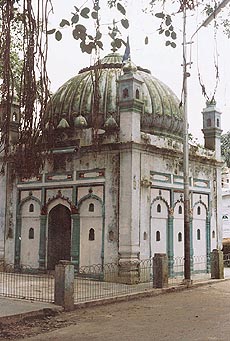
A View of Alam Procession In Nahan During Muharram
Dr.Mazhar
Naqvi
Observance of Muharram in Nahan is a
sort of miracle. There are no Imambaras or hardly Imamis in Nahan town of
Indian hilly state Himachal Pradesh. But magnificence of Muharram is in no way
inferior to any other place. People from all faiths consider it their solemn
duty to observe Muharram in the same manner as it was conducted before the
merger of princely Nahan state into Indian Union. The state had considerable
number of Imami officers during the regime of Maharaja Shamsher Prakash. They
used to perform Azadari and take out processions to mark the tragedy of Karbala
every year on Ashura. As was the custom in most princely states, people from
different faiths in Nahan used to attend Muharram ceremonies and even the rulers
had no reservation in participating in Tazia processions. The situation changed
drastically after the merger of Nahan into Indian union and migration of Imamis
to Pakistan.
At this juncture, people of Nahan took the bold step of
observing Muharram in the traditional manner. They decided to continue what was
started by Imamis as goodwill towards them. Sunni
Muslims took the maximum initiative. Hindus, Sikhs and even Christians backed
their noble cause that aimed at symbolizing Muharram in Nahan as an example of
Inter-Faith Understanding before the world. They even continued the tradition
of Aag Ka Matam(Barefoot Walk on Fire) and it is performed by Sunni youths like
Ashiq Ali. Nahan, the erstwhile capital of powerful Sirmaur state of British
India, welcomes Mausam-E-Aza after sighting of Muharram moon with the beat of
drums, assembly (Majlis) is arranged in four localities (area) of the town with traditional Muslim population, namely Gunughat,
Haripur, Ranital and Katcha Talab. In the absence of any Imambara, the
ceremonies take place in each area in an open space. The rituals begin
with Henna ceremony(Rasam Mehndi). Devotees assemble and pray for divine
blessings and fulfillment of their wishes. Offerings are made in the form of
henna, Roti Ki Churi (sweet crumbled bread), Chunni (Veil) and other items in
the form of Tabarruk(holy offerings) and even cash donations for the expenses. Provisions
for illumination around Tazias and Alams are also made. Then, Mehndi is taken
to every house on the way to the symbolic Imambara amidst marsiya reciting. Devotees
are also offered snacks, sharbat and tea en-route.
Each locality has its own individual Alam (Standard)
bearing emblem of crossed arrows and a bow, two swords, moon and star, the sign
of Ali’s hand or even a shield. Marsiya (Mourning Poetry) is also recited to highlight
the great sufferings of Imam Hussain at the behest of Caliph Yazid. On Shab-E-Ashur
(the ninth night of the moon), Tazias are carried in procession along with the
Alams. Drummers accompany Tazias and some devotees display their swordsmanship,
Patta Bazi (stick or sword fight) besides other martial arts. Till the burial
of Tazias on 10th day, constant recital of Salam (respect) and
prayers to martyrs of Karbala carries on.
Locals give due credit to the observance of Muharram even
after en-mass migration of Imamis to the ex-rulers of the state. They are of
the view that rulers of Sirmaur were very progressive and they invited talented
and able people of all faiths to serve their kingdom. Their efforts not only
made Nahan as one of the most planned cities of British India but also
developed a composite culture with respect for all. This culture is still
persisting is evident from the continuing observance of Muharram rituals even
after departure of their initiators over six decades ago. Nahan's
deep-rooted secularism is symbolised best by a modern institution called Sarv
Dham Shakti Sangam, that seeks to emphasise 'the essential unity of the essential unity of all religions.

Sarva Dharm Shakti Sangam.( Unity of All religions)
No comments:
Post a Comment